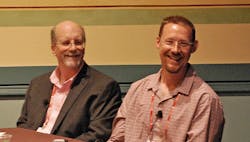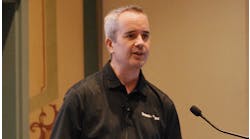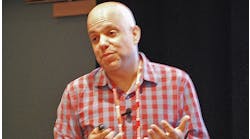Greg Heath, director of business strategy at Shape Corp. (left) and Luke Abrams, IT manager at Newman Technology (right) participated in a lively panel discussion on the many ways in which organizations can fulfill aspects of the “lights-out” manufacturing paradigm.
“Automation looks very different in every industrial environment. There’s not one specific way to do it,” said Bernard Cohen, product marketing manager at Plex Systems, and moderator of the panel discussion highlighting those many differences at this week’s ROKLive event in Orlando, Fla. The “Path to Lights-Out Manufacturing” discussion included panelists Tony Kaczmarek, vice president of product management at Plex; Luke Abrams, IT manager at Newman Technology; and Greg Heath, director of business strategy at Shape Corp. They discussed current automation efforts, combating the skilled worker shortage and the future of plant floor automation.
Accessibility to technology is the biggest change in automation over the last few decades, Kaczmarek said, led by the decreasing cost of entry for these products and the rise of the Internet. “I think we’ve always had the ability to move tons of information and reflect it. But now, to provide context around it, to be able to deliver it to the people that can affect change, those are the things that we’re really seeing make a huge impact,” Kaczmarek said.
The latest automation efforts at Shape Corp., Heath said, are about trying to simplify operations and remove menial tasks from operators. Oftentimes for companies new to automation, taking that first step is the hardest. It can require internal passion and interest to drive change. At Shape Corp., one team member in the electrical controls group drove the process. “If we didn’t start, we wouldn’t have evolved to begin with,” Heath said.
“Automation is a key part of any new lines that we put out there at this point,” said Abrams. Standardization is also a key part of that process. “We have standards that we put in place now for all our lines depending on the type of line that is,” Abrams said.
Customers are also impacting how businesses approach their automation efforts. For example, a customer has pushed Newman Technology regarding process requirements for labeling. Rather than having operators manually generate labels, customers want them to be generated consistently by a machine. Customers have also pushed the company on serialization, which was originally created for internal use at Newman. Now, customers also scan those same barcodes to validate parts on arrival.
In general, Newman uses automation for error-proofing. “You use it to be that second checker, that verification,” Abrams said. The integrated system will prevent the company from sending an incorrect part to the customer, and follow up conversations with customers also help further develop processes to ensure errors aren’t made, Abrams added.
Can new technology solve workforce issues?
According to the latest Plex Systems State of Smart Manufacturing Report, 75% of organizations say technology is highly helpful in addressing workforce challenges, and 34% of respondents have invested in process automation, which they think has helped to address workforce challenges. Cohen asked the panelists about their newest technology applications.
“As our business evolves, we’re getting into more and more products that have stricter tolerance requirements,” Heath said. This has led to discussions about investing in artificial intelligence (AI) and machine learning tools that can help in that process.
Many companies do not have IT staff to handle security and all the server and database infrastructure. “It’s shocking to me to watch the number of customers that we have that don’t have a single programmable logic controller (PLC) programmer,” Kaczmarek said. It often takes an operator on the plant floor that already has experience in maintaining the machines and the product process, or people with an IT background to expand further into operational technology. Turn those with IT responsibilities, who are trying to keep databases alive with old solutions, into analysts that are implementing new solutions, Kaczmarek recommended.
“We’re not looking at the automation side as a pure, raw dollar return on investment,” Heath said. It’s also important for the team to understand its data, he added. “As data comes streaming in you can potentially lose some of that connection to what the data represents,” Heath said.
The engineering group at Shape Corp., when buying new equipment, began to modify the build manual for suppliers, so when they receive specifications, suppliers fully understand what’s expected. “We wanted machines to come in already configured to our standard, so that every new machine got the same exact set up,” Heath said.
At Newman, they’re beginning to look at new technology for capturing data for check feeds and adding sensors that detect the location of a part or measurement, Abrams said. “Some newer cameras actually have machine learning or AI built into them, so you essentially teach them over a series of parts, what is a good part and what are the bad parts,” Abrams said.
Is industry ready for lights-out manufacturing?
A lights-out operation for an entire facility is a lofty goal, and for now, more companies are interested in fully automating specific production lines. Newman is close to lights-out but not all the way; it has one production line with two workers, one at the beginning loading parts and another at the end, loading parts into the container.
“Continue to build toward that process,” Abrams said. “It’s little by little getting that confidence that what we have in place will send a good part every single time, and if it doesn’t, the proper notification is sent out.”
Every effort bringing a facility closer to 100% lights-out is also bringing increased complexity of materials management, handling rejects or material flow between systems, Kaczmarek said. “We forget how agile a human person is to be able to handle all these little nuances,” he added. They’re seeing more smaller cells, rather than the full operation, going lights-out.
Internal citizen developers or the use of low-code/no-code software has also given the smaller to mid-sized market more opportunity in this area. Newer vision systems and robotics also provide many more opportunities to validate everything. “Unless you’re making the same part for probably two or three years, the need for agility may keep you from going fully lights-out,” Kaczmarek said. “There’s a journey to making sure that you get to a point of perfection.”
The editors of Control, Control Design and Smart Industry are reporting live from ROKLive 2022 in Orlando, Florida, to bring you the latest news and insights from the event. When the event comes to a close, the best, most important coverage will be compiled into a report by the editors.
Register now to pre-order the report and be among the first to receive it in your inbox.





